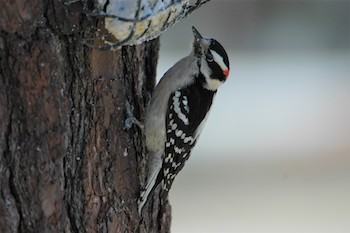
Bird Feeding Basics
Over 100 bird species in North America will supplement their diets with bird seed, suet, fruit and nectar feeders. While feeding birds, a few steps can be taken to ensure you "do no harm" to the birds. If you are not careful, you may unintentionally encourage window collisions, predation and the spread of disease.
What Works Best
Black oil sunflower and white millet are the seeds that attract the greatest variety of birds. Even though these seeds can be purchased separately, many homeowners find that it is easier to use a high-quality birdseed mixture that contains large amounts of both seeds.
Begin using only 1 or 2 feeders. Don't add additional feeders until birds regularly visit these feeders.
Position feeders at least 10 feet from cover. This permits birds to easily escape most predators while helping keep squirrels away from feeders. If a feeder must be located close to a tree or shrub, encircle the base of the feeder with wire fencing. This helps reduce the chances that feeding birds will be captured by raptors, cats and other predators.
Offer feed at different levels. Some birds prefer to feed on the ground, while others like to feed at elevated feeders. It is generally best to put different seed types in different feeders. This reduces waste as many birds will throw out the seed they don't want.
Do not put seed directly on the ground as this will lead to mold. You can place seed on a plate, shallow tray or pie pan, or something similar.
Keep cats inside, or at least place feeders well away from bushes where cats may hide to catch birds.

Keep Feeders Clean
Don't over-fill feeders. Stock them with only enough food to last a couple of days.
Keep seeds dry. Dispose of wet seeds before they become moldy. Remove and dispose of discarded seeds and hulls regularly. Wet seeds and hulls can promote the growth of fungi and bacteria that can be harmful to birds. Also, sunflower hulls contain a growth inhibitor that can suppress plants from growing near feeders.
Dirty feeders can be a source of disease, so keep them clean. Every few weeks wash them in warm soapy water and disinfect them by washing/soaking them in a solution consisting of 1 part bleach to 10 parts hot water. After disinfecting the feeders with bleach, rinse them thoroughly with water and allow to fully dry before refilling with seeds.
Winter Feeding
Once bird feeding begins in winter, continue stocking feeders with seed throughout the entire season. Bird feeding can enhance bird survival during harsh weather.
Bird feeding was once considered primarily a winter activity. Today bird enthusiasts feed birds throughout the year. In fact, some homeowners attract more birds to feeders in summer than winter.
Protect Birds From Windows
The number of birds striking windows near feeders can be reduced by placing raptor silhouettes on windowpanes. Installing screens over windows or hanging ribbons and other objects in front of windows also helps prevent birds from colliding by reducing reflection in the window.
Stunned birds found below windows should be placed in a paper bag with the top loosely closed. Put the bag in a cool, dark place. Once the bird is alert, it can be returned to the wild.
If birds have struck your window, place feeders within 3 feet of the window to reduce flight speed during collisions.

Additional Resources
General Bird Feeding Information
Bird Conservation Information
To report unusual birds using feeders or for more information, contact WRD's Wildlife Conservation Section at 478-994-1438.
Preferred Dining Areas for Birds
Although birds will feed in many locations, many birds have preferences. A few of these are noted below.
Birds
Ground
Feeding Table
Feeding Tray
Hanging Feeder
●
●
●
●
●
●
●
●
●
●
●
●
●
●
●
●
●
●
●
●
●
●
●
●
●
●
●
Winter Feeding for Birds
Key to Table
● Prefer
○ Will Eat
Bird
Mixed Seed
Sunflower
Corn Bread
Suet
White Bread
Millet
Scratch Feed
Niger Seed
Peanut Butter
Peanuts
○
●
○
○
○
○
○
●
○
○
○
○
●
○
○
●
○
○
○
●
○
○
○
●
●
○
○
○
●
○
●
○
○
○
○
●
○
●
●
○
●
●
○
●
○
●
○
○
○
●
○
○
○
○
○
○
○
●
○
○
●
●
○
○
○
●
●
○
●
○
○
○
○
●
○
●
○
○
○
○
○
○
○
●
○
●
○
○
●
●
○
○
●
○
●
○
●
●
○
○
●
●
○
●
○
○
●
○
●
○
○
○
●
●
○
○
○
●
●
○
●




















